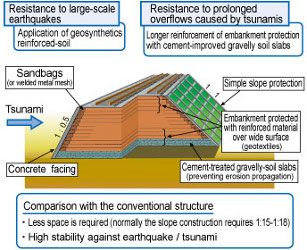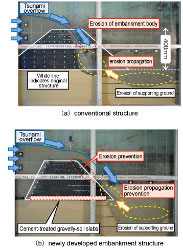4. Development of Railway Embankment Structures Resistant to severe Earthquakes and Prolonged Overflows caused by Tsunamis
Railway embankments sustained extensive damage from the tsunami triggered by the 2011 off the Pacific coast of Tohoku Earthquake and the operations of railway lines were suspended for an extended period of time. A new reinforced embankment design was therefore developed to resist seismic motion and prolonged overflows caused by Tsunamis.
Tests on a model embankment were first carried out in order to gain insight into the causes of tsunami damage. Results showed that seismic motion weakens the levee part and slope protection of the embankment. Subsequent tsunami overflow then erodes the embankment levee and the supporting ground around the toe of the slope, leading to overall instability, and eventually to collapse.
Therefore, by arranging geosynthetics reinforcement materials inside the embankment and the protective slope, resistance to seismic motion and prolonged overflows can be improved. In addition, cement-treated gravelly-soil slabs were added to the bottom of the embankment levee using both cement-treated well-graded gravel and geosynthetics. The combined use of these reinforcement measures comprises the new method designed to prevent erosion of the supporting ground due to scouring and subsequent instability of the embankment (Figure 1).
Tests on model embankments showed that the conventional type embankment resisted well to a large scale earthquake (L2 seismic motion), however half of the embankment was eroded within 6 minutes of tsunami overflow. On the other hand, the newly developed embankment was hardly affected by erosion at all (Figure 2).
Preparation of a technical manual indicating practical design and construction methods for the proposed structure is planned for the future.
Other Contents
- 1. Seismic ground motion simulator applicable to M9 earthquakes
- 2. Seismic Hazard simulator for railways
- 3. Early warning system employing ocean bottom seismometer data
- 4. Development of Railway Embankment Structures Resistant to severe Earthquakes and Prolonged Overflows caused by Tsunamis
- 5. Measures against buckling of ballasted track during earthquakes
- 6. Disaster Hazard Mapping Technology
- 7. Method for diagnosing condition of concrete roadbed in tunnels
- 8. Analytical method for evaluating carbody safety aimed at reducing passenger injury in case of level crossing collisions
- 9. Bogie to control decrement in wheel load
- 10. Mechanical pneumatic steering system with failsafe function
- 11. Gear oil for Shinkansen trains with improved startability in low temperature conditions
- 12. Process to select appropriate sounds to convey in-cab driver alerts
- 13. Training in communication techniques for train dispatchers in disrupted situations
- 1. Seismic ground motion simulator applicable to M9 earthquakes
- 2. Seismic Hazard simulator for railways
- 3. Early warning system employing ocean bottom seismometer data
- 4. Development of Railway Embankment Structures Resistant to severe Earthquakes and Prolonged Overflows caused by Tsunamis
- 5. Measures against buckling of ballasted track during earthquakes
- 6. Disaster Hazard Mapping Technology
- 7. Method for diagnosing condition of concrete roadbed in tunnels
- 8. Analytical method for evaluating carbody safety aimed at reducing passenger injury in case of level crossing collisions
- 9. Bogie to control decrement in wheel load
- 10. Mechanical pneumatic steering system with failsafe function
- 11. Gear oil for Shinkansen trains with improved startability in low temperature conditions
- 12. Process to select appropriate sounds to convey in-cab driver alerts
- 13. Training in communication techniques for train dispatchers in disrupted situations


